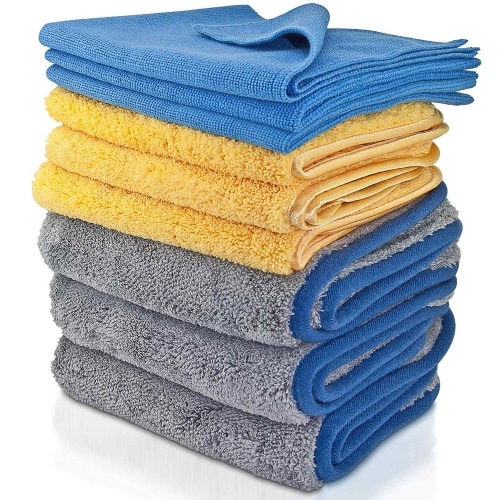There are several ways of drying your car. Drying the car with a microfiber towel is one of them. It is a very common one for detailers, because microfiber towels are easy to maintain and re-use, and they minimize the risk of swirls.
Why dry with a microfiber towel
When drying a car, you can do this indirect or direct. Indirect means that you dry the surface without actually touching it (like using an air blowing device). Direct means that you dry the surface by touching it (like wiping it with a microfiber towel).
By drying the surface with a microfiber towel, you minimize the risk of swirls and marring, and you remove the water safely. Water isn’t just made out of water alone. Tapwater especially contains calcium and magnesium, together with several other minerals and trace-elements. When the water starts to evaporate, these minerals and trace-elements stay behind. When you are working on a hot summers day, the sunlight can actually have a little magnifying glass effect within the waterdrop. This can add to the process that etches the minerals into the paint. Making them very hard to remove, and literally damaging your paint on a very small level.
The types of drying
There can be several minor differences, but in essence, there are 2 ways of drying your car with a microfiber towel.
The swipe and drag technique
This technique is the most common one. The microfiber towel is either pulled over the surface or swiped. This is an effective way to dry the car fairly quick, but there is a very small risk that by dragging the towel over the surface, you create miniature swirls. There is a long lasting discussion between the supporters of this technique and the other technique.
The drop and soak technique
This technique is not as common, but has a strong group of supporters. The microfiber towel is gently laid down on the surface, allowing it to soak up the water simply by laying on top of it. When the water is absorbed, the towel is simply picked up and laid down on another surface. The advantage is that you don’t move the towel which minimizes the risk of swirls or marring. But it could take more time and perhaps even more different towels.
Both techniques have there pros and cons. The situation might be the answer to what technique is most fitting.
Pros and cons of using a (MF) towel to dry the car
Pros:
- It is a very effective way because microfiber drying towels can absorb a lot of water
- The risk of marring and swirls is minimized
- Microfiber towels will have little to no effects on very soft surfaces or very soft paint
- A good microfiber drying towel is not only suited for drying, but can also be used to buff off polish, wax, sealant or to clean interior with if needed
Cons:
- Microfiber towels are not cheap, the good ones are a bit expensive
- Although they are not difficult to maintain, they still need a bit of care
- They are not as common to come by as an old t-shirt or blouse
Things to take into account
There aren’t many steps. There are 2 main techniques described above that pretty much sum it all up.
However, there are a few things you need to remember when using a microfiber towel:
- When a towel is dropped on the floor, put it aside and don’t use it until it has been washed. There can be very small amount of dust, dirt, sand and other particles in the towel. Using it will spread those particles over your paint, and because of the sharp sand it can even scratch the surface.
- Never wash a towel with fabric softener! The oils in this product will clog up the microscopic fibers. This will have a very negative impact on the performance that is almost impossible to undo.
- Putting the towel in the dryer after washing can help clean out any dust or lint
- As with many things, a good towel costs good money. The cheap towels are rarely worth the money spent










